Principles of Management Report: Comparing Management Approaches
VerifiedAdded on 2023/06/09
|8
|1810
|108
Report
AI Summary
This report delves into the principles of management, contrasting traditional and contemporary approaches to organizational leadership. It begins by comparing these two management styles, highlighting their core differences and impacts on business environments. The report then explores the significance of team development, referencing Tuckman's stages of group development to illustrate how teams evolve and function. Furthermore, it examines team motivation through the lens of Vroom's expectancy theory, analyzing how individual expectations and rewards influence performance. The analysis extends to collaborative efforts within teams, emphasizing the importance of communication and coordination. Overall, the report provides a comprehensive overview of management principles, offering insights into effective leadership and team dynamics.
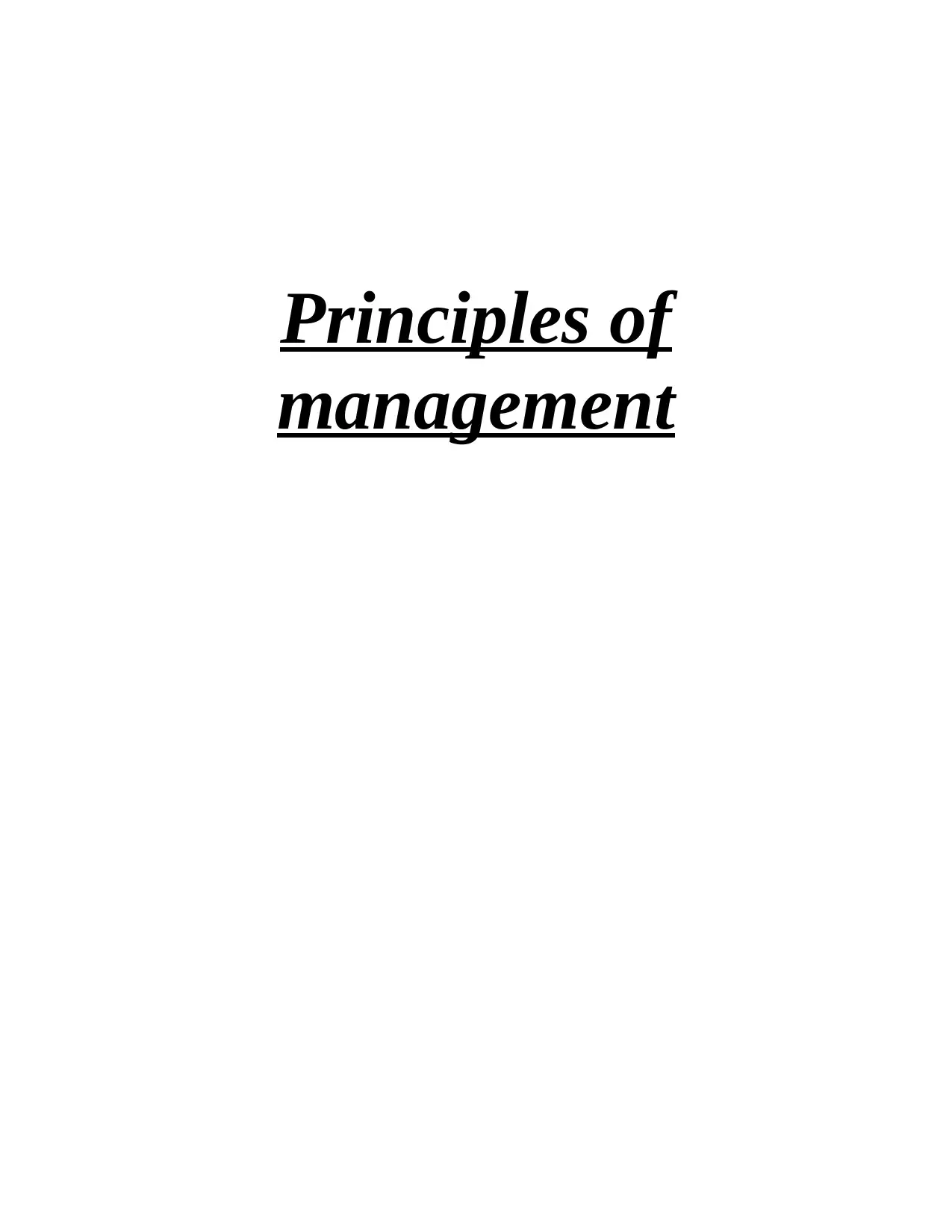
Principles of
management
management
Paraphrase This Document
Need a fresh take? Get an instant paraphrase of this document with our AI Paraphraser
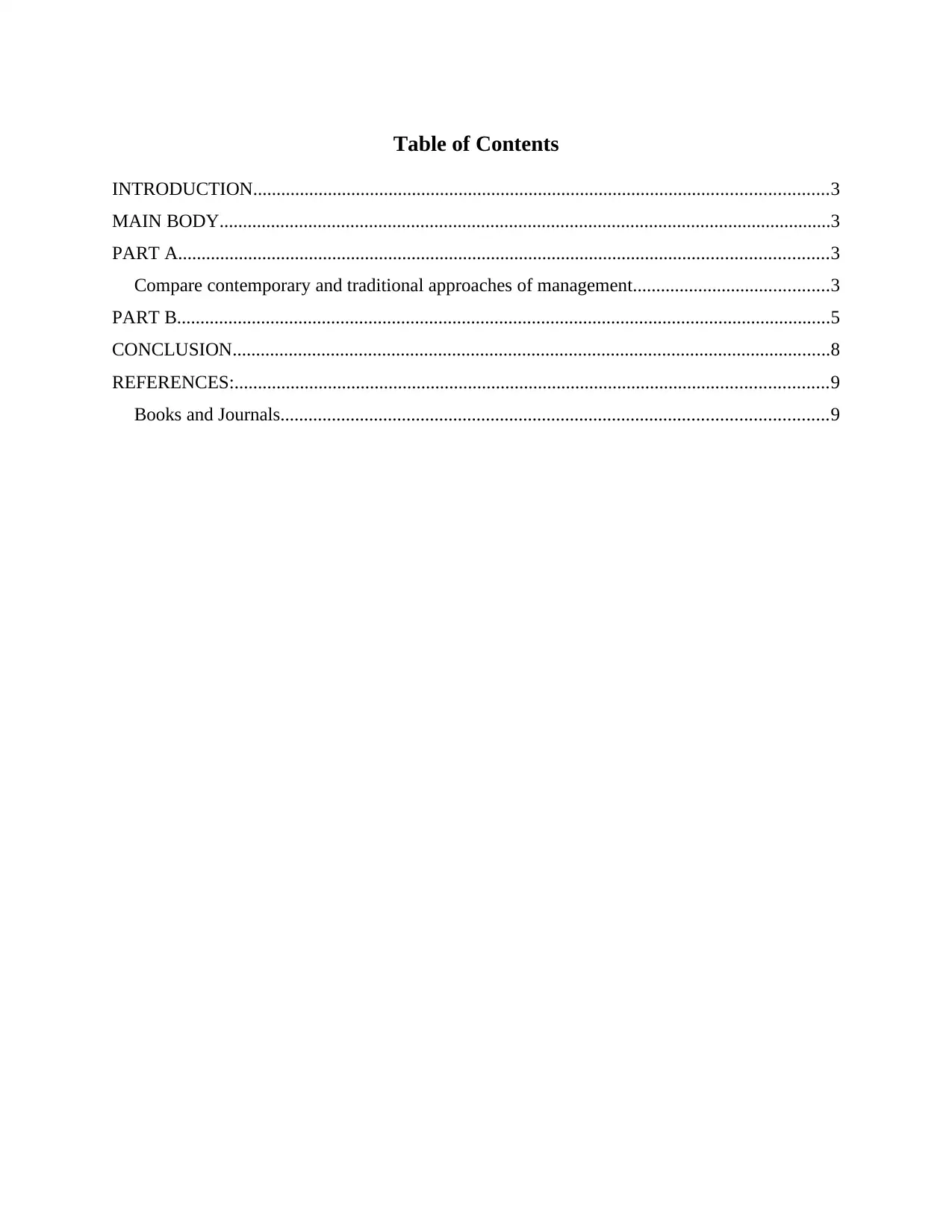
Table of Contents
INTRODUCTION...........................................................................................................................3
MAIN BODY...................................................................................................................................3
PART A...........................................................................................................................................3
Compare contemporary and traditional approaches of management..........................................3
PART B............................................................................................................................................5
CONCLUSION................................................................................................................................8
REFERENCES:...............................................................................................................................9
Books and Journals.....................................................................................................................9
INTRODUCTION...........................................................................................................................3
MAIN BODY...................................................................................................................................3
PART A...........................................................................................................................................3
Compare contemporary and traditional approaches of management..........................................3
PART B............................................................................................................................................5
CONCLUSION................................................................................................................................8
REFERENCES:...............................................................................................................................9
Books and Journals.....................................................................................................................9
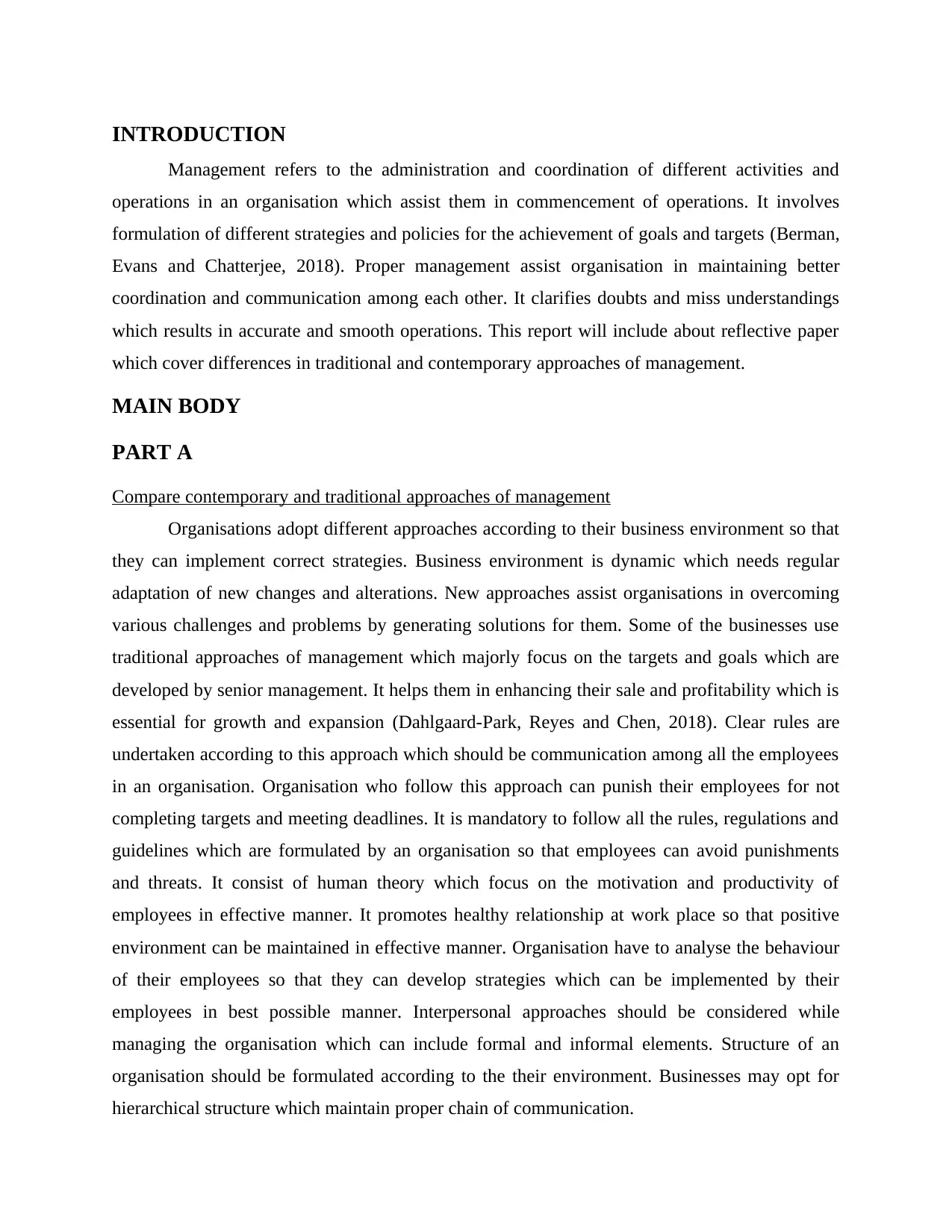
INTRODUCTION
Management refers to the administration and coordination of different activities and
operations in an organisation which assist them in commencement of operations. It involves
formulation of different strategies and policies for the achievement of goals and targets (Berman,
Evans and Chatterjee, 2018). Proper management assist organisation in maintaining better
coordination and communication among each other. It clarifies doubts and miss understandings
which results in accurate and smooth operations. This report will include about reflective paper
which cover differences in traditional and contemporary approaches of management.
MAIN BODY
PART A
Compare contemporary and traditional approaches of management
Organisations adopt different approaches according to their business environment so that
they can implement correct strategies. Business environment is dynamic which needs regular
adaptation of new changes and alterations. New approaches assist organisations in overcoming
various challenges and problems by generating solutions for them. Some of the businesses use
traditional approaches of management which majorly focus on the targets and goals which are
developed by senior management. It helps them in enhancing their sale and profitability which is
essential for growth and expansion (Dahlgaard-Park, Reyes and Chen, 2018). Clear rules are
undertaken according to this approach which should be communication among all the employees
in an organisation. Organisation who follow this approach can punish their employees for not
completing targets and meeting deadlines. It is mandatory to follow all the rules, regulations and
guidelines which are formulated by an organisation so that employees can avoid punishments
and threats. It consist of human theory which focus on the motivation and productivity of
employees in effective manner. It promotes healthy relationship at work place so that positive
environment can be maintained in effective manner. Organisation have to analyse the behaviour
of their employees so that they can develop strategies which can be implemented by their
employees in best possible manner. Interpersonal approaches should be considered while
managing the organisation which can include formal and informal elements. Structure of an
organisation should be formulated according to the their environment. Businesses may opt for
hierarchical structure which maintain proper chain of communication.
Management refers to the administration and coordination of different activities and
operations in an organisation which assist them in commencement of operations. It involves
formulation of different strategies and policies for the achievement of goals and targets (Berman,
Evans and Chatterjee, 2018). Proper management assist organisation in maintaining better
coordination and communication among each other. It clarifies doubts and miss understandings
which results in accurate and smooth operations. This report will include about reflective paper
which cover differences in traditional and contemporary approaches of management.
MAIN BODY
PART A
Compare contemporary and traditional approaches of management
Organisations adopt different approaches according to their business environment so that
they can implement correct strategies. Business environment is dynamic which needs regular
adaptation of new changes and alterations. New approaches assist organisations in overcoming
various challenges and problems by generating solutions for them. Some of the businesses use
traditional approaches of management which majorly focus on the targets and goals which are
developed by senior management. It helps them in enhancing their sale and profitability which is
essential for growth and expansion (Dahlgaard-Park, Reyes and Chen, 2018). Clear rules are
undertaken according to this approach which should be communication among all the employees
in an organisation. Organisation who follow this approach can punish their employees for not
completing targets and meeting deadlines. It is mandatory to follow all the rules, regulations and
guidelines which are formulated by an organisation so that employees can avoid punishments
and threats. It consist of human theory which focus on the motivation and productivity of
employees in effective manner. It promotes healthy relationship at work place so that positive
environment can be maintained in effective manner. Organisation have to analyse the behaviour
of their employees so that they can develop strategies which can be implemented by their
employees in best possible manner. Interpersonal approaches should be considered while
managing the organisation which can include formal and informal elements. Structure of an
organisation should be formulated according to the their environment. Businesses may opt for
hierarchical structure which maintain proper chain of communication.
⊘ This is a preview!⊘
Do you want full access?
Subscribe today to unlock all pages.

Trusted by 1+ million students worldwide
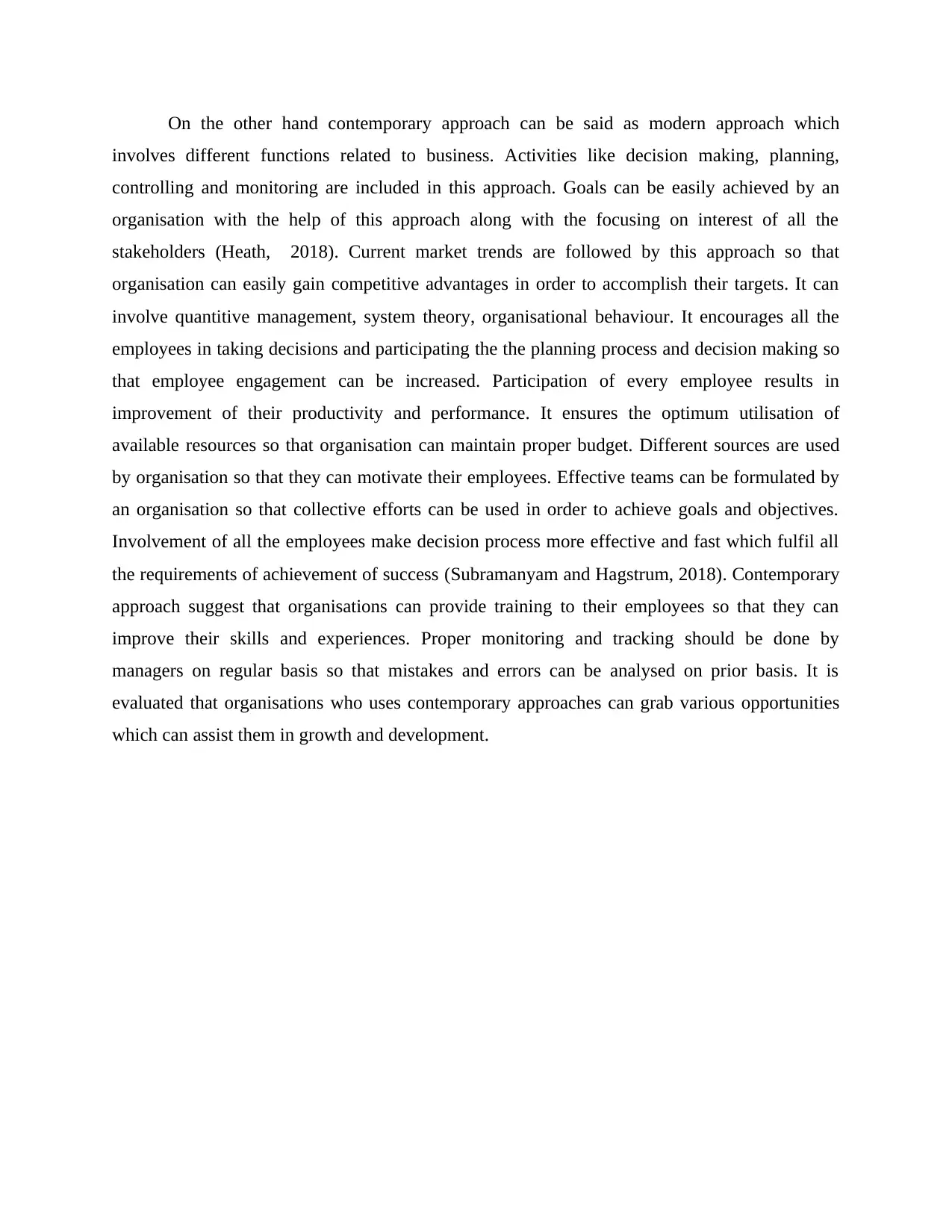
On the other hand contemporary approach can be said as modern approach which
involves different functions related to business. Activities like decision making, planning,
controlling and monitoring are included in this approach. Goals can be easily achieved by an
organisation with the help of this approach along with the focusing on interest of all the
stakeholders (Heath, 2018). Current market trends are followed by this approach so that
organisation can easily gain competitive advantages in order to accomplish their targets. It can
involve quantitive management, system theory, organisational behaviour. It encourages all the
employees in taking decisions and participating the the planning process and decision making so
that employee engagement can be increased. Participation of every employee results in
improvement of their productivity and performance. It ensures the optimum utilisation of
available resources so that organisation can maintain proper budget. Different sources are used
by organisation so that they can motivate their employees. Effective teams can be formulated by
an organisation so that collective efforts can be used in order to achieve goals and objectives.
Involvement of all the employees make decision process more effective and fast which fulfil all
the requirements of achievement of success (Subramanyam and Hagstrum, 2018). Contemporary
approach suggest that organisations can provide training to their employees so that they can
improve their skills and experiences. Proper monitoring and tracking should be done by
managers on regular basis so that mistakes and errors can be analysed on prior basis. It is
evaluated that organisations who uses contemporary approaches can grab various opportunities
which can assist them in growth and development.
involves different functions related to business. Activities like decision making, planning,
controlling and monitoring are included in this approach. Goals can be easily achieved by an
organisation with the help of this approach along with the focusing on interest of all the
stakeholders (Heath, 2018). Current market trends are followed by this approach so that
organisation can easily gain competitive advantages in order to accomplish their targets. It can
involve quantitive management, system theory, organisational behaviour. It encourages all the
employees in taking decisions and participating the the planning process and decision making so
that employee engagement can be increased. Participation of every employee results in
improvement of their productivity and performance. It ensures the optimum utilisation of
available resources so that organisation can maintain proper budget. Different sources are used
by organisation so that they can motivate their employees. Effective teams can be formulated by
an organisation so that collective efforts can be used in order to achieve goals and objectives.
Involvement of all the employees make decision process more effective and fast which fulfil all
the requirements of achievement of success (Subramanyam and Hagstrum, 2018). Contemporary
approach suggest that organisations can provide training to their employees so that they can
improve their skills and experiences. Proper monitoring and tracking should be done by
managers on regular basis so that mistakes and errors can be analysed on prior basis. It is
evaluated that organisations who uses contemporary approaches can grab various opportunities
which can assist them in growth and development.
Paraphrase This Document
Need a fresh take? Get an instant paraphrase of this document with our AI Paraphraser
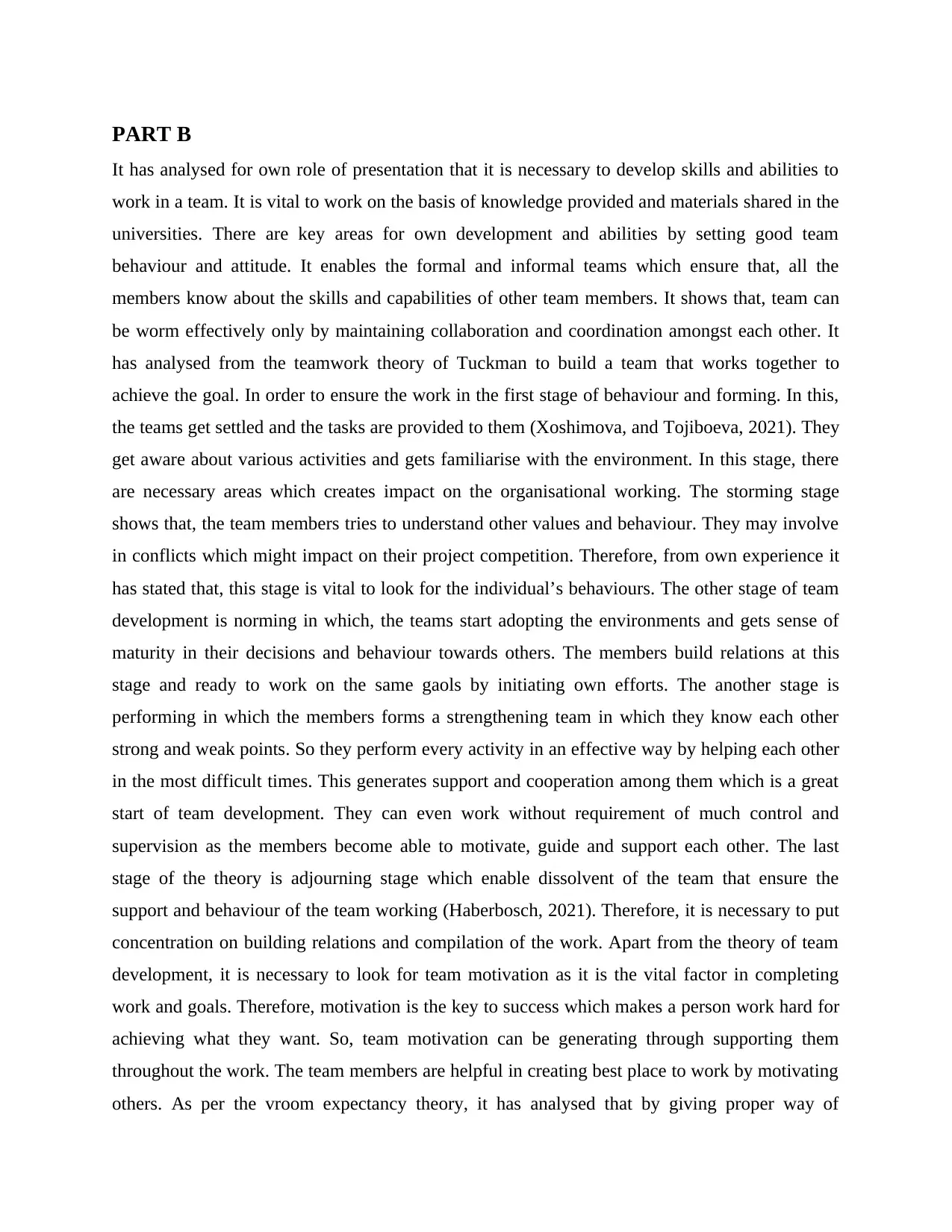
PART B
It has analysed for own role of presentation that it is necessary to develop skills and abilities to
work in a team. It is vital to work on the basis of knowledge provided and materials shared in the
universities. There are key areas for own development and abilities by setting good team
behaviour and attitude. It enables the formal and informal teams which ensure that, all the
members know about the skills and capabilities of other team members. It shows that, team can
be worm effectively only by maintaining collaboration and coordination amongst each other. It
has analysed from the teamwork theory of Tuckman to build a team that works together to
achieve the goal. In order to ensure the work in the first stage of behaviour and forming. In this,
the teams get settled and the tasks are provided to them (Xoshimova, and Tojiboeva, 2021). They
get aware about various activities and gets familiarise with the environment. In this stage, there
are necessary areas which creates impact on the organisational working. The storming stage
shows that, the team members tries to understand other values and behaviour. They may involve
in conflicts which might impact on their project competition. Therefore, from own experience it
has stated that, this stage is vital to look for the individual’s behaviours. The other stage of team
development is norming in which, the teams start adopting the environments and gets sense of
maturity in their decisions and behaviour towards others. The members build relations at this
stage and ready to work on the same gaols by initiating own efforts. The another stage is
performing in which the members forms a strengthening team in which they know each other
strong and weak points. So they perform every activity in an effective way by helping each other
in the most difficult times. This generates support and cooperation among them which is a great
start of team development. They can even work without requirement of much control and
supervision as the members become able to motivate, guide and support each other. The last
stage of the theory is adjourning stage which enable dissolvent of the team that ensure the
support and behaviour of the team working (Haberbosch, 2021). Therefore, it is necessary to put
concentration on building relations and compilation of the work. Apart from the theory of team
development, it is necessary to look for team motivation as it is the vital factor in completing
work and goals. Therefore, motivation is the key to success which makes a person work hard for
achieving what they want. So, team motivation can be generating through supporting them
throughout the work. The team members are helpful in creating best place to work by motivating
others. As per the vroom expectancy theory, it has analysed that by giving proper way of
It has analysed for own role of presentation that it is necessary to develop skills and abilities to
work in a team. It is vital to work on the basis of knowledge provided and materials shared in the
universities. There are key areas for own development and abilities by setting good team
behaviour and attitude. It enables the formal and informal teams which ensure that, all the
members know about the skills and capabilities of other team members. It shows that, team can
be worm effectively only by maintaining collaboration and coordination amongst each other. It
has analysed from the teamwork theory of Tuckman to build a team that works together to
achieve the goal. In order to ensure the work in the first stage of behaviour and forming. In this,
the teams get settled and the tasks are provided to them (Xoshimova, and Tojiboeva, 2021). They
get aware about various activities and gets familiarise with the environment. In this stage, there
are necessary areas which creates impact on the organisational working. The storming stage
shows that, the team members tries to understand other values and behaviour. They may involve
in conflicts which might impact on their project competition. Therefore, from own experience it
has stated that, this stage is vital to look for the individual’s behaviours. The other stage of team
development is norming in which, the teams start adopting the environments and gets sense of
maturity in their decisions and behaviour towards others. The members build relations at this
stage and ready to work on the same gaols by initiating own efforts. The another stage is
performing in which the members forms a strengthening team in which they know each other
strong and weak points. So they perform every activity in an effective way by helping each other
in the most difficult times. This generates support and cooperation among them which is a great
start of team development. They can even work without requirement of much control and
supervision as the members become able to motivate, guide and support each other. The last
stage of the theory is adjourning stage which enable dissolvent of the team that ensure the
support and behaviour of the team working (Haberbosch, 2021). Therefore, it is necessary to put
concentration on building relations and compilation of the work. Apart from the theory of team
development, it is necessary to look for team motivation as it is the vital factor in completing
work and goals. Therefore, motivation is the key to success which makes a person work hard for
achieving what they want. So, team motivation can be generating through supporting them
throughout the work. The team members are helpful in creating best place to work by motivating
others. As per the vroom expectancy theory, it has analysed that by giving proper way of
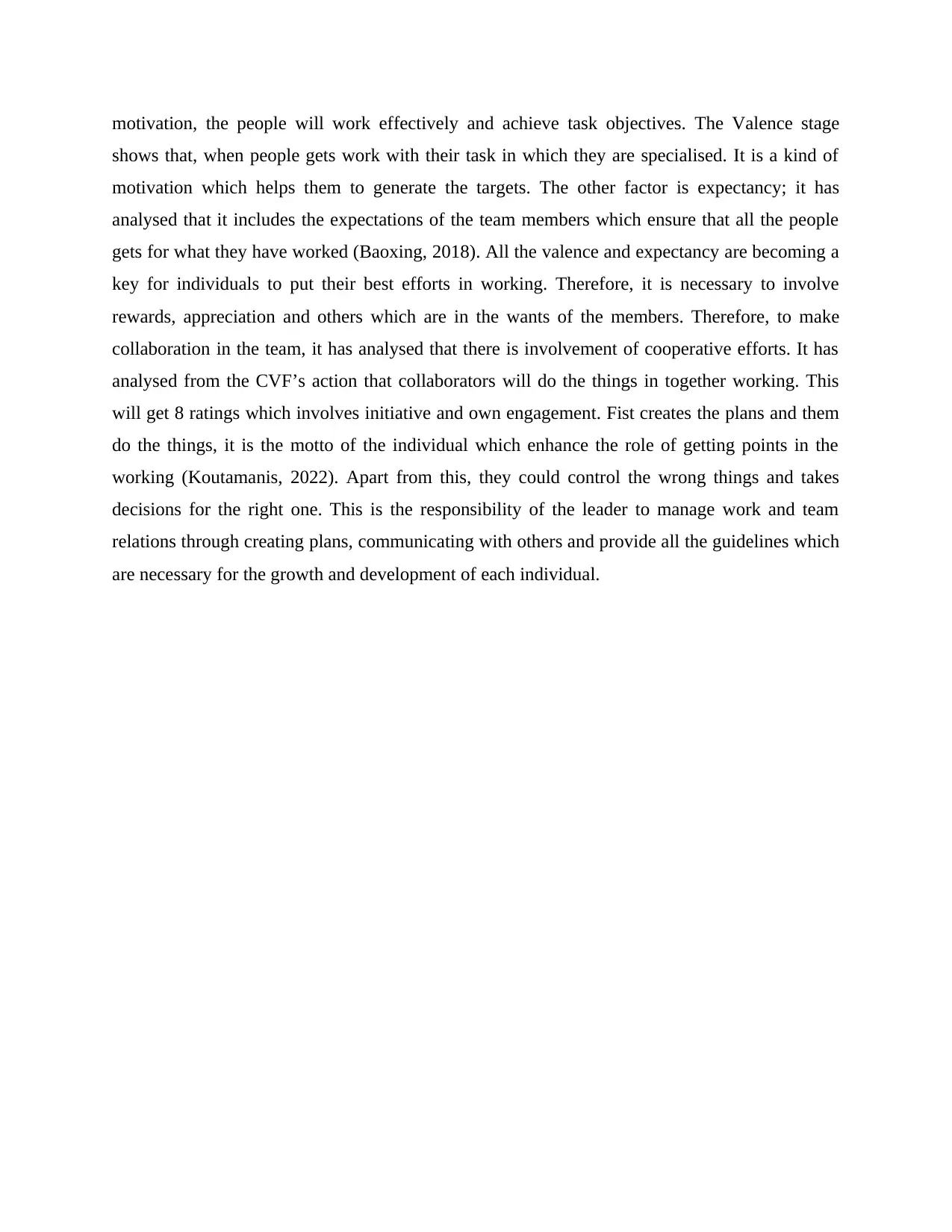
motivation, the people will work effectively and achieve task objectives. The Valence stage
shows that, when people gets work with their task in which they are specialised. It is a kind of
motivation which helps them to generate the targets. The other factor is expectancy; it has
analysed that it includes the expectations of the team members which ensure that all the people
gets for what they have worked (Baoxing, 2018). All the valence and expectancy are becoming a
key for individuals to put their best efforts in working. Therefore, it is necessary to involve
rewards, appreciation and others which are in the wants of the members. Therefore, to make
collaboration in the team, it has analysed that there is involvement of cooperative efforts. It has
analysed from the CVF’s action that collaborators will do the things in together working. This
will get 8 ratings which involves initiative and own engagement. Fist creates the plans and them
do the things, it is the motto of the individual which enhance the role of getting points in the
working (Koutamanis, 2022). Apart from this, they could control the wrong things and takes
decisions for the right one. This is the responsibility of the leader to manage work and team
relations through creating plans, communicating with others and provide all the guidelines which
are necessary for the growth and development of each individual.
shows that, when people gets work with their task in which they are specialised. It is a kind of
motivation which helps them to generate the targets. The other factor is expectancy; it has
analysed that it includes the expectations of the team members which ensure that all the people
gets for what they have worked (Baoxing, 2018). All the valence and expectancy are becoming a
key for individuals to put their best efforts in working. Therefore, it is necessary to involve
rewards, appreciation and others which are in the wants of the members. Therefore, to make
collaboration in the team, it has analysed that there is involvement of cooperative efforts. It has
analysed from the CVF’s action that collaborators will do the things in together working. This
will get 8 ratings which involves initiative and own engagement. Fist creates the plans and them
do the things, it is the motto of the individual which enhance the role of getting points in the
working (Koutamanis, 2022). Apart from this, they could control the wrong things and takes
decisions for the right one. This is the responsibility of the leader to manage work and team
relations through creating plans, communicating with others and provide all the guidelines which
are necessary for the growth and development of each individual.
⊘ This is a preview!⊘
Do you want full access?
Subscribe today to unlock all pages.

Trusted by 1+ million students worldwide
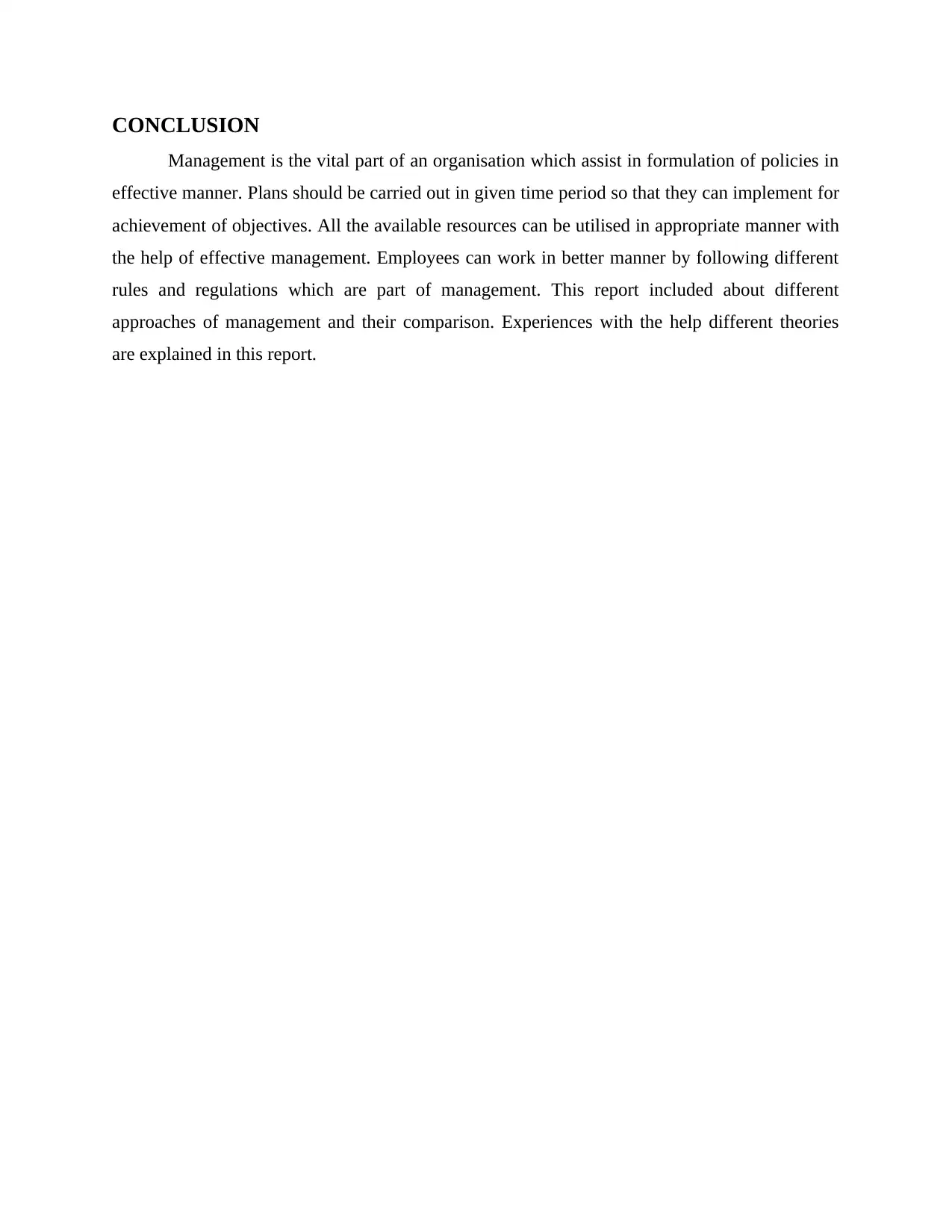
CONCLUSION
Management is the vital part of an organisation which assist in formulation of policies in
effective manner. Plans should be carried out in given time period so that they can implement for
achievement of objectives. All the available resources can be utilised in appropriate manner with
the help of effective management. Employees can work in better manner by following different
rules and regulations which are part of management. This report included about different
approaches of management and their comparison. Experiences with the help different theories
are explained in this report.
Management is the vital part of an organisation which assist in formulation of policies in
effective manner. Plans should be carried out in given time period so that they can implement for
achievement of objectives. All the available resources can be utilised in appropriate manner with
the help of effective management. Employees can work in better manner by following different
rules and regulations which are part of management. This report included about different
approaches of management and their comparison. Experiences with the help different theories
are explained in this report.
Paraphrase This Document
Need a fresh take? Get an instant paraphrase of this document with our AI Paraphraser
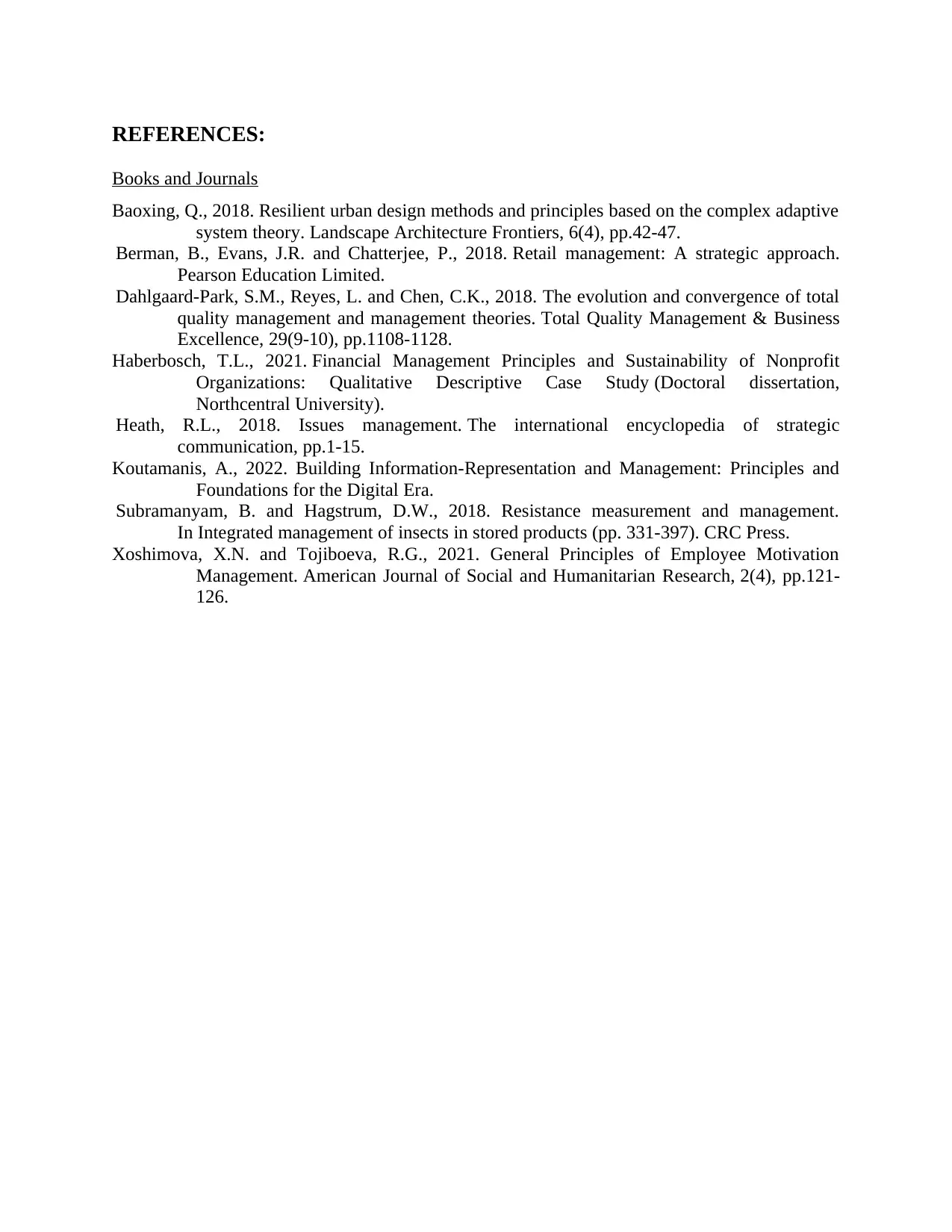
REFERENCES:
Books and Journals
Baoxing, Q., 2018. Resilient urban design methods and principles based on the complex adaptive
system theory. Landscape Architecture Frontiers, 6(4), pp.42-47.
Berman, B., Evans, J.R. and Chatterjee, P., 2018. Retail management: A strategic approach.
Pearson Education Limited.
Dahlgaard-Park, S.M., Reyes, L. and Chen, C.K., 2018. The evolution and convergence of total
quality management and management theories. Total Quality Management & Business
Excellence, 29(9-10), pp.1108-1128.
Haberbosch, T.L., 2021. Financial Management Principles and Sustainability of Nonprofit
Organizations: Qualitative Descriptive Case Study (Doctoral dissertation,
Northcentral University).
Heath, R.L., 2018. Issues management. The international encyclopedia of strategic
communication, pp.1-15.
Koutamanis, A., 2022. Building Information-Representation and Management: Principles and
Foundations for the Digital Era.
Subramanyam, B. and Hagstrum, D.W., 2018. Resistance measurement and management.
In Integrated management of insects in stored products (pp. 331-397). CRC Press.
Xoshimova, X.N. and Tojiboeva, R.G., 2021. General Principles of Employee Motivation
Management. American Journal of Social and Humanitarian Research, 2(4), pp.121-
126.
Books and Journals
Baoxing, Q., 2018. Resilient urban design methods and principles based on the complex adaptive
system theory. Landscape Architecture Frontiers, 6(4), pp.42-47.
Berman, B., Evans, J.R. and Chatterjee, P., 2018. Retail management: A strategic approach.
Pearson Education Limited.
Dahlgaard-Park, S.M., Reyes, L. and Chen, C.K., 2018. The evolution and convergence of total
quality management and management theories. Total Quality Management & Business
Excellence, 29(9-10), pp.1108-1128.
Haberbosch, T.L., 2021. Financial Management Principles and Sustainability of Nonprofit
Organizations: Qualitative Descriptive Case Study (Doctoral dissertation,
Northcentral University).
Heath, R.L., 2018. Issues management. The international encyclopedia of strategic
communication, pp.1-15.
Koutamanis, A., 2022. Building Information-Representation and Management: Principles and
Foundations for the Digital Era.
Subramanyam, B. and Hagstrum, D.W., 2018. Resistance measurement and management.
In Integrated management of insects in stored products (pp. 331-397). CRC Press.
Xoshimova, X.N. and Tojiboeva, R.G., 2021. General Principles of Employee Motivation
Management. American Journal of Social and Humanitarian Research, 2(4), pp.121-
126.
1 out of 8
Related Documents
Your All-in-One AI-Powered Toolkit for Academic Success.
+13062052269
info@desklib.com
Available 24*7 on WhatsApp / Email
![[object Object]](/_next/static/media/star-bottom.7253800d.svg)
Unlock your academic potential
Copyright © 2020–2025 A2Z Services. All Rights Reserved. Developed and managed by ZUCOL.

